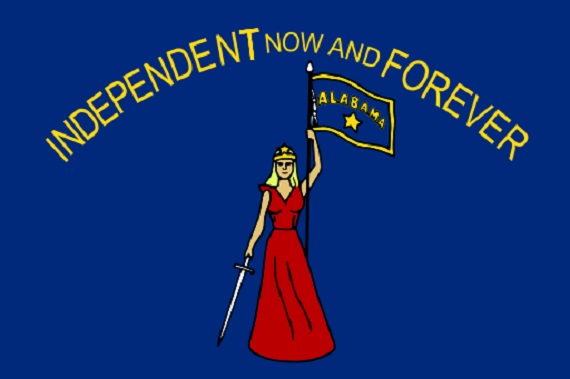The Republic of Alabama existed for a little less than a month in 1861. When the popularly elected Alabama Secession Convention of 1861 voted to secede from the Union, the State operated as a sovereign political community and freely joined the Confederate States of America as an independent State. The Confederate Constitution recognized the sovereignty of each State in its Preamble, a move designed to forever answer the question of power in the new government. The people of the States possessed all the power not delegated to the central authority, and legitimacy, the bedrock of free government, resided in the people of Alabama. They could choose to enter a compact with the other Southern States or not, and if not, Alabama would have remained a free and independent republic.
The United States Constitution was supposed to operate in this manner. Critics claim that States like Alabama, which was formed out of the common territory of the United States, could make no claim to sovereignty. This is a gross mischaracterization of the American Union.
The thirteen States which formed the federal republic of 1776 were carved out of British territory and could only claim sovereignty based on the natural rights of free Englishmen. That they succeeded in winning their independence does not alter the philosophical right. Victory codified it through the Treaty of Paris of 1783, but Thomas Jefferson satisfied the question of legitimacy when he asserted the free and independent status of each State in the Declaration of Independence. The people of the States acknowledged their State legislatures to be the legitimate center of government, not the Crown and Parliament. The same held true in 1860 and 1861 across the South.
Alabama’s population in 1861 was a shade under 1,000,000, and approximately forty-four percent were slaves. The question then becomes, had Alabama rejected joining a union with the other Southern States (and ignoring the possibility of war) and with only around 500,000 citizens, could Alabama have successfully operated as an independent republic in 1861 with such a small population? Certainly.
The 1861 population of Alabama exceeded that of every State in the Union in 1790. Only Virginia came close in 1790 with around 750,000 people, including 250,000 slaves. But early federal Virginia flourished. Virginia produced some of the greatest men in American history: Washington, Jefferson, Madison, Henry, Taylor, Randolph, Marshall, Clark, Lee, Tyler, Harrison, and Monroe to name a few. Its government, though undemocratic, was arguably the most effective in the Union, particularly in regard to civil liberties. Its economy was sound enough to retire their portion of the public debt before Alexander Hamilton’s assumption scheme in 1791, and its citizen militia performed well in the American War for Independence, not to mention regulars like Washington and “Lighthorse Harry” Lee. In other words, Virginia, with a free population equal to that of 1861 Alabama, had a sound political, economic, and military base. Clearly, larger does not always equal better.
While Alabama lacked major industry, its economy was solid enough to foster considerable prosperity. Alabama ranked in the top ten of per capita income in the United States in 1860, and even if it had remained independent, Alabama would have had close connections with other industrial States, most importantly Great Britain and New York, that is if Alabama had been allowed to seek self-determination in peace. Only the War and Reconstruction wrecked her economy and impoverished her people.
Today, Alabama has more people than the entire United States in 1790 (4.5 million compared to 3.8 million). Her largest cities, Birmingham and Montgomery, would have been metropolises in 1790, surpassing Philadelphia, Boston, and New York in total population. Her gross domestic product ranges from industrial and manufactured goods (steel and automobiles) to agricultural products. The State has three fine research institutions, including Tuskegee Institute, the premier historically black university in the United States, and a thriving scientific and technology base in Huntsville.
For those who believe that Alabama retains the policies of the Jim Crow era, think again. The State’s black population is around twenty-six percent. Twenty-six percent of the State legislators in the House are black, and twenty percent of the Senate. Compare that to eight percent in the United States House of Representatives and two percent in the United States Senate respectively (black Americans constitute about thirteen percent of the total population in the United States). But no one would dare call the United States Congress “Jim Crow.” Where do black Alabamians have more power? The answer should be clear.
The 2010 Abbeville Institute Scholar’s Conference resulted in the book Rethinking the American Union. The premise of the Conference and the book are simple: size matters and America is too big to function properly as a republic. Americans who have become disillusioned with government in Washington D.C. should start considering alternatives to the “United State” of America and the one-size fits all policies advanced by both mainstream political parties. Republican government in Washington is an illusion, but not at the State and local level.
I tell people I live in the Republic of Alabama. We have a flag, now all we need is a backbone and a purpose.








I stumbled across this story while researching more detailed history rather than the accepted history, law and commerce. The last paragraph caught my attention because I’ve talked to hundreds of people over the years dealing with history and word definitions and always felt alone in the Republic of Alabama or Alabama state. If you know anyone in south Alabama or group I appreciate direction.
Chris